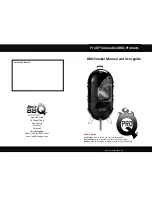
AES 23rd International Conference, Copenhagen, Denmark, 2003 May 23-25
1
Statistical Analysis of an Automated
In-Situ Frequency Response Optimisation
Algorithm for Active Loudspeakers
Andrew Goldberg
1
and Aki Mäkivirta
1
1
Genelec Oy, Olvitie 5, 74100 Iisalmi, Finland.
ABSTRACT
This paper presents a novel method for automatically selecting the optimal in-situ acoustical frequency response of
active loudspeakers within a discrete-valued set of responses offered by room response controls on active
loudspeakers. The rationale of the room response controls for the active loudspeakers is explained. The frequency
response, calculated from the acquired impulse response, is used as the input for the optimisation algorithm to select
the most favourable combination of room response controls. The optimisation algorithm is described. The perform-
ance of the algorithm is analysed and discussed. This algorithm has been implemented and is currently in active use
by specialist loudspeaker system calibrators who set up and tune studios and listening rooms.
1. INTRODUCTION
This paper presents a system to optimally set the room
response controls currently found on full-range active
loudspeakers to achieve a desired in-room frequency
response. The active loudspeakers [1] to be optimised
are individually calibrated in anechoic conditions to
have a flat frequency response magnitude within de-
sign limits of ±2.5 dB.
When a loudspeaker is placed into the listening envi-
ronment the frequency response changes due to loud-
speaker-room interaction. To help alleviate this, the
active loudspeakers incorporate a pragmatic set of
room response controls, which account for common
acoustic issues found in professional listening rooms.
Although many users have the facility to measure
loudspeaker in-situ frequency responses, they often do
not have the experience of calibrating active loud-
speakers. Even with experienced system calibrators,
significant variance between calibrations can be seen.
Furthermore, with a number of different people cali-
brating loudspeaker systems, additional variance in
results will occur. For these reasons an automated
calibration method was developed to ensure consis-
tency of calibrations.
Presented first in this paper is the discrete-valued
room response equaliser employed in the active loud-
speakers. Then, the algorithm for automated value se-
lection is explained including the software structure,
algorithm, features and operation. The performance of
the optimisation algorithm is then investigated by
studying the statistical properties of frequency re-
sponses before and after equalisation.
2. IN-SITU EQUALISATION AND ROOM
RESPONSE CONTROLS
2.1. Equalisation
Techniques
The purpose of room equalisation is to improve the
perceived quality of sound reproduction in a listening
environment. The goal of in-room equalisation is usu-
ally not to convert the listening room to anechoic. In
fact, listeners prefer to hear some room response in
the form of liveliness that can create a spatial impres-
sion and some envelopment [2].
An approach to improve the performance of a loud-
speaker in a room is to choose an optimal location for
the loudspeaker. Cox and D’Antonio [3] (Room Opti-
miser) use a computer model of the room to find op-
timal loudspeaker positions and acoustical treatment
location to give an optimally flat in-situ frequency re-
sponse magnitude. Positional areas for the loud-
speaker and listening locations can be given as con-
straints to limit the final solution. Problems with this
approach are that an optimisation may not be practi-
cally possible in all cases and that this is only half of
the installation process, as the loudspeaker should be
corrected for problems caused by the loudspeaker-
room interaction too.
Electronic equalisation to improve the subjective
sound quality has been widespread for at least 40
years; see Boner & Boner [4] for an early example.


































